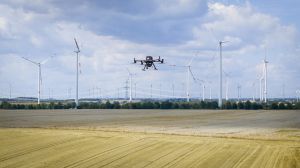The Vestas V112
is one of the best-known wind turbines from the Danish manufacturer Vestas.
It is characterized by high efficiency, flexibility and sound optimization.
In the case of wind turbines such as the V112, which are designed for high performance and
long service life, the regular inspection of the
rotor blades are essential. This is the only way to ensure that the system
continuously works efficiently and detects potential damage at an early stage
and be fixed.
One of the
The most important methods for rotor blade inspection today is the use of
Drones. Especially with modern turbines with large hub heights and
rotor diameters, this technology ensures safe, efficient and
is a cost-effective alternative to traditional inspection methods. In this
articles will describe the specific requirements for rotor blade inspection in
of the Vestas V112 and the advantages of drone technology for this
task explained.
The Vestas V112:
An overview
Technical
Key data of the V112
The Vestas V112
is a wind turbine that is specially designed for medium to strong
wind speeds. With a nominal output of 3.0 MW (3000 MW)
kW), it is one of the high-performance wind turbines that can be used both onshore and
can also be used offshore.
To the
Key technical data of the V112 include:
- Rotor diameter:112
Metre
- Hub height:
Variants from 84 to 140 meters, depending on the tower configuration
-Generator:
Permanent Magnet Synchronous Generator
Special
Features of the V112
The Vestas V112
convinces with a number of special features that make it a preferred
Making the choice for wind farm operators:
- Efficiency: Thanks
Due to its design, the V112 achieves high efficiency values even at low to low temperatures.
average wind speed.
- Sound optimization:
The rotor blades are designed to minimize the noise level, which
especially when installed near settlements of large
significance.
-Flexibility:
The V112 can be installed in different wind classes, which makes it flexible
for use in different geographical regions.
These features
make the V112 an advanced wind turbine that can achieve high
requirements. In order to maintain this performance in the long term,
is a regular and thorough inspection of the rotor blades
indispensable.
Why are
Rotor blade inspections important?
The rotor blades
of a wind turbine are crucial for its energy production and are
constantly under high mechanical loads. These burdens result from
the interplay of wind speed, direction and weather conditions.
Damage to the rotor blades can significantly reduce the efficiency of the turbine
and, in the worst case, lead to a total failure.
Typical damages,
that can be detected during an inspection are:
- Cracks in the
Surface
- Delaminations
- Lightning strike marks
- Erosion on
the edges of the blades
Early
Detecting and repairing this damage can prevent costly breakdowns and reduce the
Extend the service life of the rotor blades.
Challenges
in the inspection of traditional methods
Traditional
Inspection methods, such as rope access, are subject to significant challenges
especially in the case of modern wind turbines such as the Vestas V112, which
hub heights of up to 140 meters.
-Vulnerabilities:
Working at great heights is associated with considerable risks.
Rope access techniques require highly specialized teams and always recover
Accident hazard.
-Time exposure:
Inspection with rope access is time-consuming. Each rotor blade must be individually
which can lead to long downtimes of the plant.
- Costs: The
high security requirements and the time required make the
traditional inspection costly.
These
Challenges have led to wind turbine operators
are increasingly looking for alternative inspection methods. Here comes the
Drone technology comes into play.
Drone Technology:
The future of rotor blade inspection
Advantages of the
Drone technology
The Inspection
of rotor blades by means of drones has proven to be the most important
future-oriented technology has been established. Especially for plants like Vestas
V112, which impresses with its height and large rotor diameter, offers
the use of drones has numerous advantages:
-Safety:
Drone inspections reduce the need for people to stay in dangerous
heights. The drones can be operated autonomously or by a secure
site, reducing the risk to the inspection team.
is minimized.
-Efficiency:
Drones are able to inspect rotor blades in a much shorter time
than is possible with traditional methods. A drone can easily control the
fly over the entire surface of a rotor blade and capture high-resolution images and
Record videos.
-Cost reduction:
By reducing the inspection time and increasing safety, the
the cost of the inspection. In addition, possible damage can be done more quickly
identified and rectified, which in turn reduces plant downtime
minimized.
-Quality
and error detection: Modern drones are equipped with high-resolution cameras
that make even the smallest damage visible. By using
infrared cameras and special software solutions for image evaluation, the
error detection rate can be significantly increased.
Drone inspection
in practice
In practice,
drone technology has proven itself both onshore and offshore.
This is particularly the case with offshore installations, where access to the wind turbines is often
difficult and weather-dependent, drone technology provides an optimal
solution. Drones are able to carry out even difficult
weather conditions and deliver reliable results.
For operators of
wind turbines, this means that inspections will be carried out more on schedule and
can be carried out more reliably without compromising the safety of the
personnel is endangered or the plants are at a standstill for longer periods of time
must.
Integration into
Existing maintenance processes
The integration
of drone technology into existing maintenance and inspection processes
requires some conversion, but in the long term it offers numerous
Advantages. Many companies now rely on a combination of
regular drone inspections and traditional maintenance. The
Drone technology enables rapid and comprehensive verification of the
rotor blades, while targeted repairs are carried out by specialized teams if necessary.
can be carried out.
Result:
Drone technology as standard for the Vestas V112
The Vestas V112
is a modern wind turbine that is characterized by its efficiency, flexibility and
Sound optimization convinces. In order to achieve this performance over the entire
service life of the system, a regular inspection of the
Rotor blades indispensable.
The traditional
Rope access technology, however, reaches its limits for systems of this size.
Border. Drone inspections offer a safe, efficient and
cost-effective alternative. They enable fast and precise
inspection of the rotor blades, reduce the risk of accidents for the
maintenance personnel and contribute to minimizing downtime.
For operators and
operator of wind turbines, drone technology is therefore the
optimal choice when it comes to improving the efficiency and safety of your equipment
. Especially with the Vestas V112, whose size and
performance places special demands on the inspection, the
use of drones is a future-proof investment that will pay off in the long term
will pay out.
Through the
Implementing regular drone inspections can reduce potential damage
detected and remedied at an early stage, which not only affects the service life of the
blades, but also the profitability of the entire plant
Increases. The future of rotor blade inspection clearly belongs to the
Drone technology – a must-have for any operator looking for safety,
efficiency and cost-effectiveness.



















